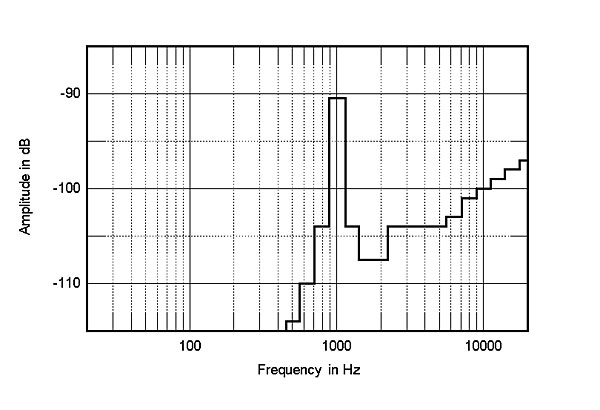| Columns Retired Columns & Blogs |
What dates are the early production and late production?
We have started to include in Stereophile's reviews of digital products the 1/3-octave analyzed spectrum of a player's output while it reproduces the dithered –90.31dB tone from the CBS CD-1 test CD. With an undithered signal, a tone at this level only crosses three quantizing levels and therefore is not sufficiently described for it to be reproduced as a sinewave. However, as the code representing this tone on track 19 on the CBS disc has had an appropriate amount of dither noise added when the CD was cut, it should reproduce as a pure, if noisy, sinewave. Any distortion components present can therefore be laid at the door of the individual player's decoder and electronics.
A 1/3-octave spectrum analyzer obviously does not have sufficient resolving power to reveal individual distortion harmonics of a 1kHz tone higher than the 8th, and the Audio Control SA3050A analyzer we use has too limited a dynamic range to reveal the presence of harmonics that are significantly lower than –20dB with respect to the fundamental. Nevertheless, it is good enough to reveal major differences between CD players, giving an approximate idea of the levels of low-order distortion components present at low levels, as well as the level of power-supply–related noise. The graphical representation of a player's low-level performance is more informative, therefore, than a straight statement of by how many dB it compresses or expands the level at –90.31dB. (The rising level in the two octaves above 5kHz in all the spectra is due mainly to the dither noise on the CD. However, as its level is not quite constant from player to player, it must also contain a contribution from decoder-generated spuriae.)
Fig.1 shows the noise/spuriae spectrum for the Adcom GCD-575. Any level error at –90.31dB was below the resolving power of the Audio Control analyzer (footnote 1). Power-supply noise was below the measurement threshold at –112dB. The Adcom was also excellent when it came to distortion, the main harmonics present being third, fourth, and fifth, all at –104dB; ie, –14dB with respect to the fundamental and as good as the "hi-bit" Yamaha CDX-1110U at less than half the price.

The maximum output level is higher than usual at 2.55V from the fixed-output sockets, which will make the Adcom sound considerably louder in uncompensated switched A/B tests against other players. From the variable sockets, controlled by a front-panel knob, the '575's MOL is a high 5.15V, making it suitable for direct-driving even the most insensitive power amplifiers.
The Adcom showed rather more frequency-response variation than the other players, being 0.7dB down at 20kHz and 2.3dB down at 4Hz. With the "Analog Frequency/Phase Contouring" (AFPC) switched in, the response was markedly altered, as shown by fig.2. The entire midrange is boosted by just over 1dB, while the treble is shelved down by 2dB, this superimposed upon the intrinsic slight HF droop. ("AFPC" seems rather a fancy label for what, to judge from the curve in fig.2, is a shaping network consisting of two resistors and a capacitor per channel.) De-emphasis was accurate, though similar to the Adcom's basic response in being down 0.4dB at 16kHz.—John Atkinson
